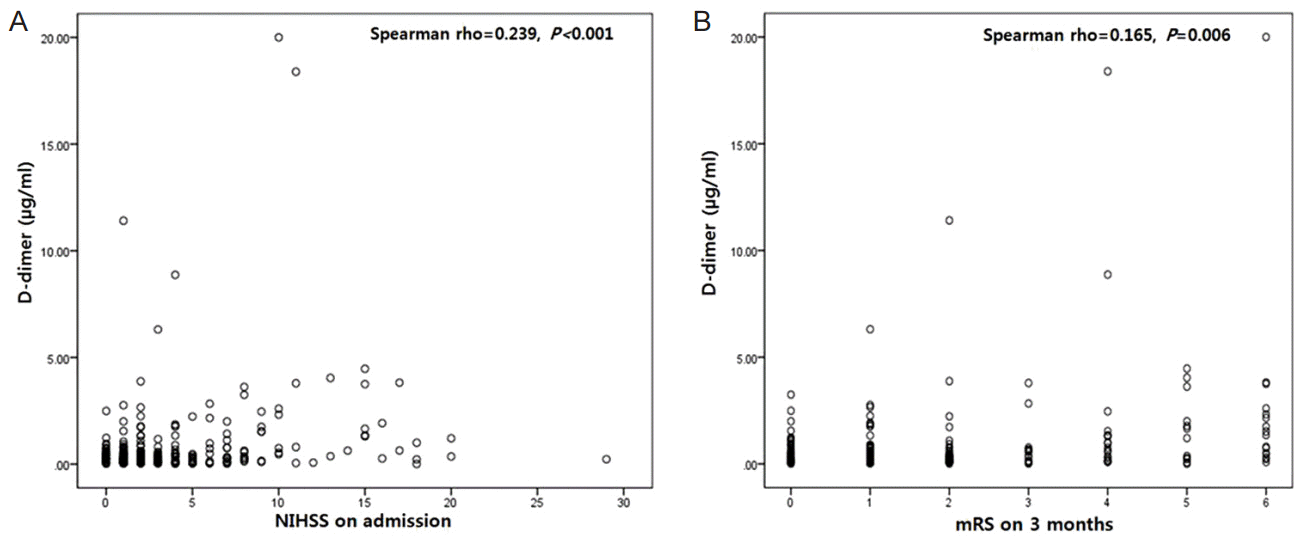1. Kim JS. Stroke becomes the 3rd important cause of death in Korea; is it a time to toast? J Stroke. 2014; 16:55–6.

2. Howard G, Walker MD, Becker C, Coull B, Feibel J, McLeroy K, et al. Community hospital-based stroke programs: North Carolina, Oregon, and New York. III. factors influencing survival after stroke: proportional hazards analysis of 4219 patients. Stroke. 1986; 17:294–9.

3. Vila N, Castillo J, Dávalos A, Chamorro A. Proinflammatory cytokines and early neurological worsening in ischemic stroke. Stroke. 2000; 31:2325–9.

4. Whiteley W, Jackson C, Lewis S, Lowe G, RumLey A, Sandercock P, et al. Inflammatory markers and poor outcome after stroke: a prospective cohort study and systematic review of interleukin-6. PLoS Med. 2009; 6:e1000145.

5. Tripodi A. D-dimer testing in laboratory practice. Clin Chem. 2011; 57:1256–62.

6. Haapaniemi E, Tatlisumak T. Is D-dimer helpful in evaluating stroke patients? A systematic review. Acta Neurol Scand. 2009; 119:141–50.

7. Dougu N, Takashima S, Sasahara E, Taguchi Y, Toyoda S, Hirai T, et al. Differential diagnosis of cerebral infarction using an algorism combining atrial fibrillation and D-dimer level. Eur J Neurol. 2008; 15:295–300.
8. Matsumoto M, Sakaguchi M, Okazaki S, Furukado S, Tagaya M, Etani H, et al. Relationship between plasma (D)-dimer level and cerebral infarction volume in patients with nonvalvular atrial fibrillation. Cerebrovasc Dis. 2013; 35:64–72.

9. Barber M, Langhorne P, RumLey A, Lowe GD, Stott DJ. Hemostatic function and progressing ischemic stroke: D-dimer predicts early clinical progression. Stroke. 2004; 35:1421–5.
10. Welsh P, Barber M, Langhorne P, RumLey A, Lowe GD, Stott DJ. Associations of inflammatory and haemostatic biomarkers with poor outcome in acute ischaemic stroke. Cerebrovasc Dis. 2009; 27:247–53.

11. Tombul T, Atbas C, Anlar O. Hemostatic markers and platelet aggregation factors as predictive markers for type of stroke and neurological disability following cerebral infarction. J Clin Neurosci. 2005; 12:429–34.

12. Kang DW, Yoo SH, Chun S, Kwon KY, Kwon SU, Koh JY, et al. Inflammatory and hemostatic biomarkers associated with early recurrent ischemic lesions in acute ische ischemic stroke. Stroke. 2009; 40:1653–8.
13. Squizzato A, Ageno W, Finazzi S, Mera V, Romualdi E, Bossi A, et al. D-dimer is not a long-term prognostic marker following acute cerebral ischemia. Blood Coagul Fibrinolysis. 2006; 17:303–6.

14. Di Napoli M, Papa F; Villa Pini Stroke Data Bank Investigators. Inflammation, hemostatic markers, and antithrombotic agents in relation to long-term risk of new cardiovascular events in first-ever ischemic stroke patients. Stroke. 2002; 33:1763–71.

15. Rallidis LS, Vikelis M, Panagiotakos DB, Liakos GK, Krania E, Kremastinos DT. Usefulness of inflammatory and haemostatic markers to predict short-term risk for death in middle-aged ischaemic stroke patients. Acta Neurol Scand. 2008; 117:415–20.

16. Lip GY, Blann AD, Farooqi IS, Zarifis J, Sagar G, Beevers DG. Sequential alterations in haemorheology, endothelial dysfunction, platelet activation and thrombogenesis in relation to prognosis following acute stroke: The west birmingham stroke project. Blood Coagul Fibrinolysis. 2002; 13:339–47.

17. Ageno W, Finazzi S, Steidl L, Biotti MG, Mera V, Melzi D’Eril G, et al. Plasma measurement of D-dimer levels for the early diagnosis of ischemic stroke subtypes. Arch Intern Med. 2002; 162:2589–93.

18. Park YW, Koh EJ, Choi HY. Correlation between serum Ddimer level and volume in acute ischemic stroke. J Korean Neurosurg Soc. 2011; 50:89–94.

19. Adams HP Jr, Bendixen BH, Kappelle LJ, Biller J, Love BB, Gordon DL, et al. Classification of subtype of acute ischemic stroke. Definitions for use in a multicenter clinical trial. TOAST. Trial of Org 10172 in acute stroke treatment. Stroke. 1993; 24:35–41.

20. Bonita R, Beaglehole R. Recovery of motor function after stroke. Stroke. 1988; 19:1497–500.

21. Stein PD, Hull RD, Patel KC, Olson RE, Ghali WA, Brant R, et al. D-dimer for the exclusion of acute venous thrombosis and pulmonary embolism: a systematic review. Ann Intern Med. 2004; 140:589–602.
22. Yuan W, Shi ZH. The relationship between plasma D-dimer levels and outcome of Chinese acute ischemic stroke patients in different stroke subtypes. J Neural Transm (Vienna). 2014; 121:409–13.

23. Hirano K, Takashima S, Dougu N, Taguchi Y, Nukui T, Konishi H, et al. Study of hemostatic biomarkers in acute ischemic stroke by clinical subtype. J Stroke Cerebrovasc Dis. 2012; 21:404–10.

24. Sacco RL, Shi T, Zamanillo MC, Kargman DE. Predictors of mortality and recurrence after hospitalized cerebral infarction in an urban community: the Northern Manhattan stroke study. Neurology. 1994; 44:626–34.
25. Yang XY, Gao S, Ding J, Chen Y, Zhou XS, Wang JE. Plasma Ddimer predicts short-term poor outcome after acute ischemic stroke. PLoS One. 2014; 9:e89756.

26. Koch HJ, Horn M, Bogdahn U, Ickenstein GW. The relationship between plasma D-dimer concentrations and acute ischemic stroke subtypes. J Stroke Cerebrovasc Dis. 2005; 14:75–9.

27. Berge E, Friis P, Sandset PM. Hemostatic activation in acute ischemic stroke. Thromb Res. 2001; 101:13–21.

28. Robson SC, Shephard EG, Kirsch RE. Fibrin degradation product D-dimer induces the synthesis and release of biologically active IL-1 beta, IL-6 and plasminogen activator inhibitors from monocytes in vitro. Br J Haematol. 1994; 86:322–6.






 PDF
PDF Citation
Citation Print
Print



 XML Download
XML Download